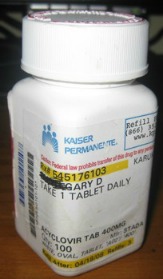Herpes Zoster Treatment Options for
People with Shingles
Herpes zoster treatments are used to treat Shingles, an infection characterized by painful blisters on a band of skin.
Although it rarely spreads to other parts of the body, a case of shingles is still very contagious and you should take care with the infection while on an outbreak.
Once you have already established that you have a case of herpes zoster or shingles infection, its then time that you learn of the various herpes zoster treatment options that are available for you.
Remember that while knowing of these options will undoubtedly give you an idea of what you can take to alleviate the pain and perhaps shorten the duration of the infection, it is still important that you consult with your attending physician. They are the most qualified individuals to prescribe you the correct medications.
Herpes Zoster Treatment: Home Remedies
Home remedies for herpes zoster are geared toward alleviating the pain and itch that are generally associated with the infection. Home remedies are available as over-the-counter drugs or anti-itch ointments that will surely reduce the pain and duration of the herpes zoster infection.
Keep the area clean
One of the foremost things you can do with your infection while at home is to clean the infected area thoroughly every day. This way, you can at least minimize the chances of infecting another person.
Anti-itching Lotions
Anti-itching lotions help alleviate the pain of an itch that herpes zoster infections provide. Using anti-itching lotions for the sores will also help prevent the possibility of getting scars due to excessive scratching the infected area.
Cold Compresses
Another topical method for herpes zoster treatment is by placing a cold compress on the infected area of a herpes zoster infection. This will help alleviate any discomfort, in such a way that it also helps get rid of the itch that the infection may cause.
Aluminum Acetate Solutions
Aluminum acetate solutions like Domeboro or Burow’s will help keep the blisters dry. It will also help prevent oozing of the blisters onto the uninfected skin. These effective treatments will allow the sores to heal faster.
Herpes Zoster Treatment: Medications
While it is true that there are home practices that might decrease the course of the herpes zoster infection, there are some instances that need medical intervention such as in cases of chronic or severe herpes zoster infections.
Here are some of the medically available options for you to try under the guidance of your physician:
Antivirals

Antivirals are used against herpes zoster infections as a virus called the Varicella Zoster Virus causes it. Antiviral agents have been proven in the treatment of herpes zoster through its inhibition of viral DNA replication.
Antivirals that are considered to work best against the infection are: acyclovir, valacyclovir, or famciclovir.
Antivirals are given to shorten the duration of the active rash, as well as to reduce the infection’s severity.
Antiviral therapy for varicella zoster infection is to be initiated within the first 72 hours of the onset of the rash; otherwise the efficacy of the therapy is drastically lowered.
Note that the antivirals are supposed to be taken from 7 days to 21 days, depending on the severity of the infection or your physician’s advice.
Analgesics
A herpes zoster infection is somewhat painful, which may prompt the use of analgesic herpes zoster treatment or other forms of pain medications. Analgesics are most effective for cases of acute herpes zoster infection. Analgesics must be taken with the right dosage and under careful regulation.
Corticosteroids
Although the efficacy of the use of corticosteroids is still under debate, many of physicians all over the world have prescribed their use to reduce acute pain. The most used corticosteroid for this is oral prednisone.
Corticosteroids for treatment of herpes zoster are used on a steady dose for about 1 week. Starting from the earliest possible time during the course of the infection and eventually tapered down over about 1 to 2 weeks.
Corticosteroids are also known to tone down the inflammation of the infected area.
Non-steroidal Anti-Inflammatory Therapy or Narcotics
Non-steroidal anti-inflammatory drugs (NSAIDs) are used in cases when blisters of a herpes zoster infection may produce mild discomfort. In some cases, when the pain experienced by the infected person is characterized from moderate to severe, narcotic drugs may be indicated.
Injection Therapy
Injection therapy is another form of herpes zoster treatment that is usually indicated in herpes zoster infections to lower the pain perceived by the affected person. This type of therapy usually consists of local anesthetics, steroids, and sympathetic blocks, which also help in decreasing instances of post-herpetic neuralgia in some people.
What is my next step?
Now that you’ve read up about herpes zoster treatment, it’s time to take further steps to ensure you are on your way to healing and happiness.
- Consult your physician. If you see signs and symptoms of a herpes zoster infection, best is to visit your doctor immediately so that they can properly diagnose and prescribe you with medication.
- Consider an online pharmacy. Let’s face it, herpes zoster treatment medications can get expensive. Save money by purchasing your antiviral medication at a trusted off-shore pharmacy like 4rx.
An episode of herpes zoster or shingles can be problematic to get, however note that with the proper care and management of the infection, recovery from the infection will be easy.
Most people with Shingles will definitely get better and are unlikely to have another outbreak again.
Chances are, it will be over before you even know it!
Back to Top of Herpes Zoster Treatment page


